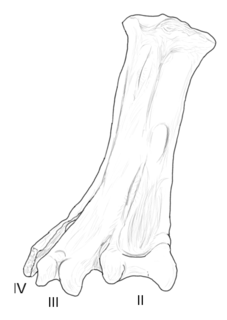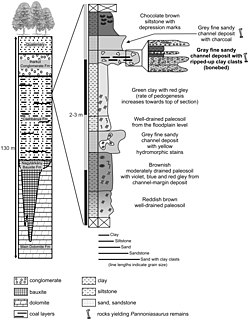
Shuvuuia is a genus of bird-like theropod dinosaur from the late Cretaceous period of Mongolia. It is a member of the family Alvarezsauridae, small coelurosaurian dinosaurs which are characterized by short but powerful forelimbs specialized for digging. The type species is Shuvuuia deserti, or "desert bird". The name Shuvuuia is derived from the Mongolian word shuvuu (шувуу) meaning "bird".

Parvicursor is a genus of tiny maniraptoran dinosaur with long slender legs for fast running. At only about 39 centimetres from snout to end of tail, and 162 grams in weight, it was initially seen as one of the smallest non-avian dinosaurs known from an adult specimen. However, in 2022 its holotype was concluded to represent a juvenile individual.

Alvarezsauridae is a family of small, long-legged dinosaurs. Although originally thought to represent the earliest known flightless birds, a consensus of recent work suggests that they evolved from an early branch of maniraptoran theropods with some paleontologists such as Paul Sereno placing them as ornithomimosaurs. Alvarezsaurids were highly specialized. They had tiny but stout forelimbs, with compact, bird-like hands. Their skeletons suggest that they had massive breast and arm muscles, possibly adapted for digging or tearing. They had long, tube-shaped snouts filled with tiny teeth. They have been interpreted as myrmecophagous, adapted to prey on colonial insects such as termites, with the short arms acting as effective digging instruments to break into nests.

The Enantiornithes, also known as enantiornithines or enantiornitheans in literature, are a group of extinct avialans, the most abundant and diverse group known from the Mesozoic era. Almost all retained teeth and clawed fingers on each wing, but otherwise looked much like modern birds externally. Over eighty species of Enantiornithes have been named, but some names represent only single bones, so it is likely that not all are valid. The Enantiornithes became extinct at the Cretaceous–Paleogene boundary, along with Hesperornithes and all other non-avian dinosaurs.

Hesperornithes is an extinct and highly specialized group of aquatic avialans closely related to the ancestors of modern birds. They inhabited both marine and freshwater habitats in the Northern Hemisphere, and include genera such as Hesperornis, Parahesperornis, Baptornis, Enaliornis, and Potamornis, all strong-swimming, predatory divers. Many of the species most specialized for swimming were completely flightless. The largest known hesperornithean, Canadaga arctica, may have reached a maximum adult length of 2.2 metres (7.2 ft).

Aralosaurus was a genus of hadrosaurid dinosaur that lived during the Late Cretaceous in what is now Kazakhstan. It is known only by a posterior half of a skull and some post-cranial bones found in the Bostobe Formation in rocks dated from the Upper Santonian-Lower Campanian boundary, at about 83.6 Ma. Only one species is known, Aralosaurus tuberiferus, described by Anatoly Konstantinovich Rozhdestvensky in 1968. The genus name means Aral Sea lizard, because it was found to the northeast of the Aral Sea. The specific epithet tuberiferus means bearing a tuber because the posterior part of the nasal bone rises sharply in front of the orbits like an outgrowth. Aralosaurus was originally reconstituted with a nasal arch similar to that of North American Kritosaurus. For many years, Aralosaurus was thus placed in the clade of the Hadrosaurinae. This classification was invalidated in 2004, following the re-examination of the skull of the animal which allowed to identify in Aralosaurus many typical characters of Lambeosaurinae. In particular, this study revealed that Aralosaurus had a hollow bony structure located far in front of the orbits, which communicated with the respiratory tract. This structure being broken at its base, its shape and size unfortunately remains undetermined. More recently, Aralosaurus has been identified as the most basal Lambeosaurinae, and placed with its close relative Canardia from the upper Maastrichtian of France in the new clade of Aralosaurini.
The Plottier Formation is a geologic formation that outcrops in the Argentine Patagonian provinces of Río Negro and Neuquén. It is the younger of two formations belonging to the Río Neuquén Subgroup within the Neuquén Group of the Neuquén Basin, with the oldest rocks dating from the late Coniacian and its youngest maybe from the very start of the Santonian. Formerly, that subgroup was treated as a formation, and the Plottier Formation was known as the Plottier Member.

The Anacleto Formation is a geologic formation with outcrops in the Argentine Patagonian provinces of Mendoza, Río Negro, and Neuquén. It is the youngest formation within the Neuquén Group and belongs to the Río Colorado Subgroup. Formerly that subgroup was treated as a formation, and the Anacleto Formation was known as the Anacleto Member.

The Barun Goyot Formation is a geological formation dating to the Late Cretaceous Period. It is located within and is widely represented in the Gobi Desert Basin, in the Ömnögovi Province of Mongolia.

Yungavolucris is a genus of enantiornithean birds. It contains the single species Yungavolucris brevipedalis, which lived in the Late Cretaceous. The fossil bones were found in the Lecho Formation at estancia El Brete, Argentina."Yungavolucris brevipedalis" means "Short-footed Yungas bird". The generic name, Yungavolucris is after the Yungas region + the Latin volucris, which translates to "bird". The specific name brevipedalis is from the Latin brevis, which means "short", + pedalis, from the Latin pes, meaning "foot".
Neogaeornis is a controversial prehistoric genus of diving bird. The single known species, Neogaeornis wetzeli, was described from fossils found in the Campanian to Maastrichtian Quiriquina Formation of Chile. It lived about 70-67 million years ago. It remains known from the single tarsometatarsus described in 1929 by Lambrecht, and today housed in the Paläontologisches Institut und Museum in Kiel, Germany.
Elsornis is a genus of enantiornithine bird. Only one species is known, Elsornis keni. It lived during the Late Cretaceous. It is known from a partially articulated fossil skeleton found in the Gobi Desert in Mongolia.
Dalianraptor is a dubious genus of prehistoric bird that lived in China about 120 million years ago, during the Early Cretaceous Period that was found in the Jiufotang Formation of China that was initially believed to have been a possible dromaeosaurid before it was described. It is very similar to the contemporary avialian Jeholornis, though it has a longer digit I (thumb-equivalent) and shorter forelimbs, which suggests it may have been flightless. Reaching about 80 centimetres (31 in) in length, it was found in Jiufotang Formation rocks in Liaoning Province.

The Yixian Formation is a geological formation in Jinzhou, Liaoning, People's Republic of China, that spans about 1.6 million years during the early Cretaceous period. It is known for its fossils, listed below.

The Csehbánya Formation is a geological formation in the Transdanubian Mountains of Veszprém County, Hungary. The formation dates to the Late Santonian of the Late Cretaceous. It represents a floodplain environment as opposed to the swampy lacustrine environment of the simultaneous Ajka Coal Formation, though there is complete overlap in terms of fauna. It underlies the Jákó Marl Formation, and laterally transitions to the Ajka Coal Formation.
Samrukia is a genus of large Cretaceous pterosaurs known only from a single lower jaw discovered in Kazakhstan. The holotype and only known specimen was collected from the Santonian-Campanian age Bostobynskaya Formation in Kyzylorda District. It was described by Darren Naish, Gareth Dyke, Andrea Cau, François Escuillié, and Pascal Godefroit in 2012, and the type species is named Samrukia nessovi. The species is named after Lev Nessov, a paleontologist, and the genus is named after Samruk, a magical bird of Kazakh folklore.

Hollanda is a genus of small ground birds known from fossils found in the Barun Goyot Formation of Mongolia. Found at Khermeen Tsav, it dates from the late Cretaceous period, about 75 million years ago. Known only from partial hind limbs, Hollanda has long legs with an unusual configuration of the toes. These indicate that it was a fast-running ground bird, possibly similar to the modern Roadrunner. Its relationships are uncertain. Some studies have found that it was an relatively advanced bird, a member of the Ornithurae, related to birds like Ichthyornis. Other studies have recovered it as a member of the primitive family Songlingornithidae. A more expansive study found it as an enantiornithean.

Luis María Chiappe is an Argentine paleontologist born in Buenos Aires who is best known for his discovery of the first sauropod nesting sites in the badlands of Patagonia in 1997 and for his work on the origin and early evolution of Mesozoic birds. He is currently the Vice President of Research and Collections at the Natural History Museum of Los Angeles County and director of the museum's Dinosaur Institute. He was a postdoctoral researcher at the American Museum of Natural History, New York after immigrating from Argentina. Chiappe is currently the curator of the award winning Dinosaur Hall at the Natural History Museum of Los Angeles County, an adjunct professor at the University of Southern California, BBC advisor and author of scientific and popular books.

Vegaviidae is an extinct family of ornithurines, often regarded as stem-anseriforms, which existed during the Late Cretaceous and possibly the Paleocene. Fossils attributed to the family have been found in Canada, Chile, New Zealand, and Antarctica.





























